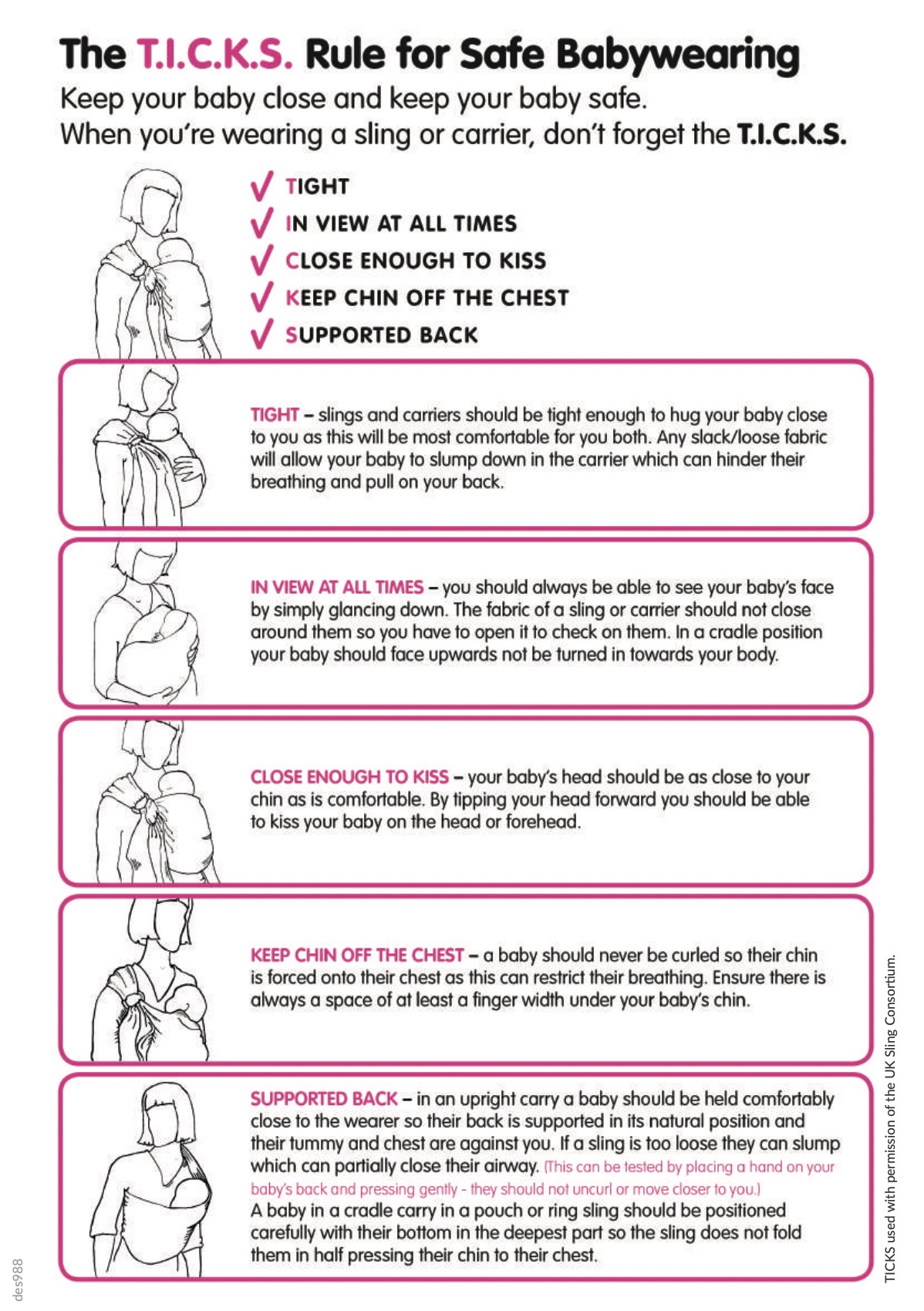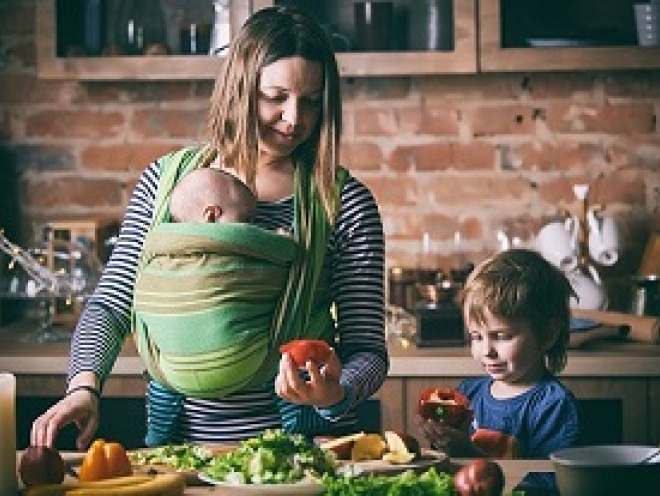Baby carriers and slings can be useful for holding a baby hands free but it is important to use them safely. Here we explain more.
What is a sling, wrap or carrier?
A sling, wrap or carrier provides comfort and support for your baby and allows you to carry your child hands free. It’s not a new phenomenon and has been practised for centuries in different cultures. We’ll use the terms sling, wrap and carrier interchangeably in the rest of this article.
There are lots of types of slings so it’s worth finding out about the different styles, and even trying a few before you buy one. Read our article Which baby carrier, wrap or sling is best for me? to find out more.
Are there are any benefits to using a sling?
Many parents say it’s practical, whatever your lifestyle. Try tidying up or getting lunch ready for your toddler with a newborn in a baby carrier or baby sling. You’ll probably see what they mean.
Slings help with transportation but they can also help parents and babies to bond and stay active while navigating the changes of new parenthood (Whittle, 2019; Williams and Turner, 2020). Parents of multiple babies may find it easier if one baby is held in a sling, and slings can provide an accessible way for parents with limited mobility to transport their baby. Carrying a baby in a sling can also be an opportunity for co-parents to share closeness and nurture their babies (Whittle, 2021).
Research has found that parents who carry their babies tend to be more responsive to their babies as they are in close contact. This promotes bonding and interactions that improve their baby’s speech, social and emotional development (Anisfeld et al, 1990; Williams and Turner, 2019; Norholt, 2020). Some studies suggest that for mothers, it can have positive mental health benefits, lowering stress and promoting breastfeeding (Norholt, 2020).
What are the risks of using slings?
Although rare, unfortunately some babies have been injured and even died in baby slings and carriers. A sling’s fabric or fabric from a parent’s clothing can press against a baby’s airways and cause suffocation very quickly. Because babies do not have strong neck control and cannot lift their head, if incorrectly positioned their airway can also become restricted (Batra et al, 2015; Rowe et al, 2022).
If your baby was born premature, with a low birth weight or has a medical condition, please discuss the safe use of a carrier or sling with a health professional.
How can I keep my baby safe in their sling, wrap or carrier?
When it comes to using slings, it’s very important to make sure you’re following a few simple guidelines. You’ll need to check the manufacturer’s instructions, following their advice for whether the size, weight and age of your baby is right for the sling. If the instructions are missing, for example because you bought the sling secondhand, contact the manufacturer directly for a copy or download a copy from the manufacturer's website.
Before you use the sling or carrier, check for signs of wear and tear. Don't use it if you have any concerns. The safest baby carrier to use will keep the baby in an upright position, well supported and comfortably close to the your body, where you can always see their face. The child's weight should be distributed evenly across the wearer's shoulders, hips and back (ROSPA, 2022).
When your baby is in the wrap, check them often, making sure their nose and mouth are clear and they can breathe easily. Keep their chin off their chest and make sure nothing is covering their face. This is especially important when carrying young babies under four months old. The UK Sling Consortium’s TICKS checklist gives the following guidance:

(UK Sling Consortium, 2015)
Baby positions for slings and carriers
A recommended position is known as the spread squat, jockey position or M-position. The spread squat is where the baby is facing their adult and has their thighs spread around the wearer’s torso. The baby also has their hips bent so their knees are slightly higher than their buttocks, or at buttock level with the thighs supported.
This practice is beneficial for at least the first 6 months for correct hip development, and also encourages social development as they are facing their caregiver. It is particularly important if a baby is being held in a sling for long periods of time (International Hip Dysplasia Institute, 2022). Read more about hip dysplasia (hips growing abnormally) in our article about it.
Can I breastfeed in a sling?
Using a sling while breastfeeding is associated with a longer duration of breastfeeding, due to convenience and the increased responsiveness that comes with keeping a baby close throughout the day (Pisacane et al, 2012; Little, 2019). It’s important to know how to do it safely though. Do make sure you check the manufacturer’s instructions as some suggest you don’t breastfeed in their slings. Here are our tips:
1. Check your baby can breathe easily and their mouth and nose are clear
2. Support your baby at all times.
3. Return your baby to a proper carrying position immediately after feeding.
This page was last reviewed in February 2024.
Further information
Our support line offers practical and emotional support with feeding your baby and general enquiries for parents, members and volunteers: 0300 330 0700.
You might find attending one of our NCT New Baby courses helpful as they give you the opportunity to explore different approaches to important parenting issues with a qualified group leader and other new parents in your area.
Make friends with other parents-to-be and new parents in your local area for support and friendship by seeing what NCT activities are happening nearby.
For more information on the slings available, find your nearest NCT sling library. Our sling libraries have a wide variety of slings and carriers to try and hire so you can find which one works best for you.
Anisfeld E, Casper V, Nozyce M, Cunningham N. (1990) Does infant carrying promote attachment? An experimental study of the effects of increased physical contact on the development of attachment. Child Dev. 61(5):1617-1627.
Batra EK, Midgett JD, Moon RY. (2015) Hazards associated with sitting and carrying devices for children two years and younger. J Pediatr. 167(1):183-187. Available at: https://doi.org/10.1016/j.jpeds.2015.03.044
International Hip Dysplasia Institute. (2022) Baby wearing. Available at: https://hipdysplasia.org/baby-wearing/ [Accessed 16th June 2022]
Little E. (2019) Culture, carrying, and communication: beliefs and behavior associated with babywearing. Infant Behav Dev. 57:101320. Available at: https://doi.org/10.1016/j.infbeh.2019.04.002
Norholt H. (2020) Revisiting the roots of attachment: A review of the biological and psychological effects of maternal skin-to-skin contact and carrying of full-term infants. Infant Behav Dev. 60:101441. Available at: https://doi.org/10.1016/j.infbeh.2020.101441
Pisacane A, Continisio P, Filosa C, Tagiamonte V, Continisio I. (2012) Use of baby carriers to increase breastfeeding duration among term infants: the effects of an educational intervention in Italy. Acta Paediatr. 101(10):e434-8. Available at: https://doi.org/10.1111/j.1651-2227.2012.02758.x
Rowe, S Reeves P, McAdams R, Roberts K, Dobson N, McKenzie L. (2022) Baby wearing injuries presenting to emergency departments, 2011-2020: a dangerous fashion trend. Available at: https://publications.aap.org/pediatrics/article/149/1%20Meeting%20Abstr… [Accessed 23rd May 2022]
ROSPA. (2022) Baby slings. Available at: https://www.rospa.com/home-safety/advice/product/baby-slings [Accessed 16th June 2022]
UK Sling Consortium. (2015) The T.I.C.K.S. rule for safe babywearing. Available at: http://babyslingsafety.co.uk [Accessed 23rd May 2022]
Whittle R. (2019) Baby on board: the impact of sling use on experiences of family mobility with babies and young children. Mobilities. 14(2). Available at: https://doi.org/10.1080/17450101.2018.1533682
Whittle R. (2021) Towards interdependence: using slings to inspire a new understanding of parental care. Child Geogr. Available at: https://doi.org/10.1080/14733285.2021.1955091
Williams L, Turner P. (2020) Experiences with “babywearing”: trendy parenting gear or a developmentally attuned parenting tool? Child Youth Serv Rev. 112:104918. Available at: https://doi.org/10.1016/j.childyouth.2020.104918






